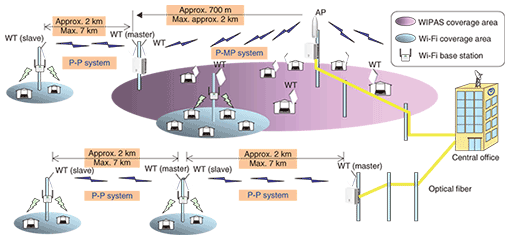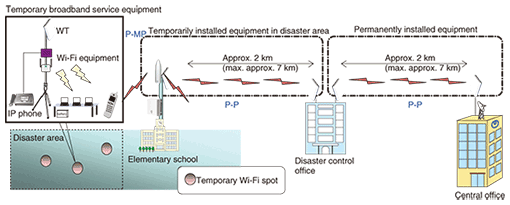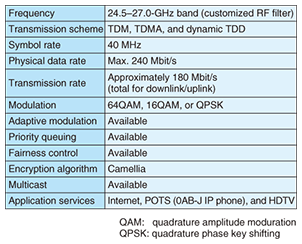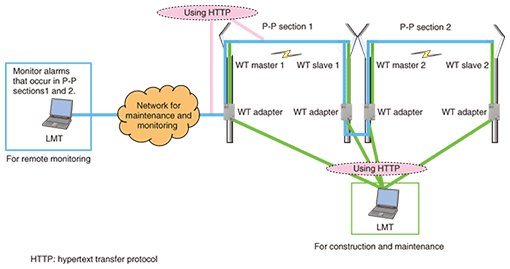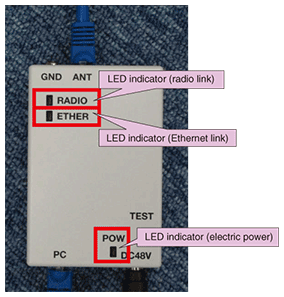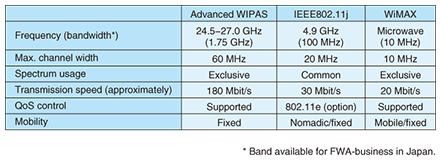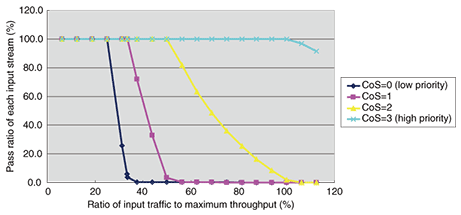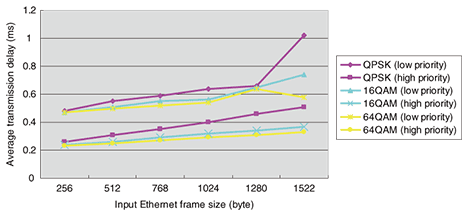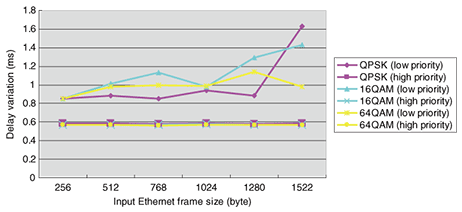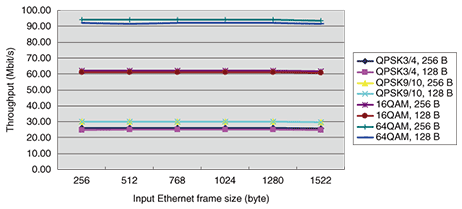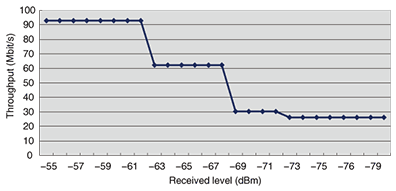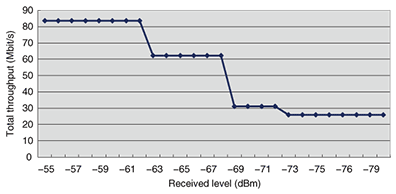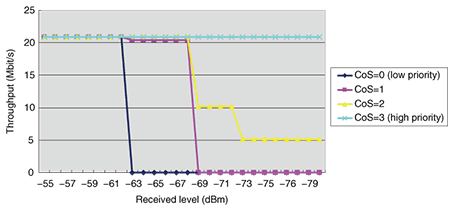 |
|||||||||||
|
|
|||||||||||
|
Letters Vol. 8, No. 11, pp. 48–56, Nov. 2010. https://doi.org/10.53829/ntr201011le1 Advanced Wireless IP Access System (Advanced WIPAS) Compatible with FTTHAbstractThis article introduces the system concept, specifications, and some measurement results for the Advanced Wireless IP Access System (Advanced WIPAS) compatible with fiber to the home (FTTH), for which a prototype was developed in March 2010 (IP: Internet protocol). A wireless terminal prototype aimed at commercial use has been completed. Advanced WIPAS is a fixed wireless access system that can provide triple-play services, i.e., high-speed Internet access services, voice-over-IP (VoIP) services, and multicast high-definition television (HDTV) video transmission services. The system will help overcome the digital divide.
1. IntroductionThe broadband infrastructure including cable television and fiber to the home (FTTH) is developing in urban areas along with increases in demand for high-speed Internet access. On the other hand, broadband services have not yet been developed in rural areas because of the high construction costs in those areas. To overcome the problem of the digital divide, we have developed a prototype of the Advanced Wireless IP Access System (Advanced WIPAS), a fixed wireless access (FWA) system with a fiber + radio architecture that can provide high-speed Internet access service with a throughput of over 100 Mbit/s, plain old telephone service (POTS) by voice-over-IP (VoIP) service with 0AB-J telephone quality, and multicast high-definition television (HDTV) streaming service (IP: Internet protocol). In this article, we introduce the system concept and specifications. Measurement results for a prototype designed for commercial use are also presented. 2. System conceptAdvanced WIPAS is an FWA system that can be deployed in a broadband network infrastructure to provide triple-play services in rural areas. The system topology can be configured as a point-to-multipoint (P-MP) or point-to-point (P-P) connection. The proposals for application to a broadband service infrastructure and application in disaster control measures are shown in Figs. 1 and 2, respectively.
For a broadband service infrastructure (Fig. 1), a P-MP system with an omnidirectional access point (AP) antenna will mainly be deployed in situations where, for example, individual houses are spread out over a wide area. In the P-MP system, a wireless terminal (WT) is attached to a user’s house. A P-P system is achieved by pairing two WTs, and it can be applied to backhaul links etc. Advanced WIPAS can provide broadband service economically to rural areas where FTTH is unavailable because of the high cost. If a Wi-Fi system is connected to the WT, it can provide broadband service more economically. For disaster countermeasures (Fig. 2), a backhaul link will be prepared from the central office to the disaster control office using the P-P system of Advanced WIPAS. After a disaster, broadband services can be quickly provided by installing an Advanced WIPAS AP on a building near the disaster area. The main parameters for Advanced WIPAS are listed in Table 1. Demands to reduce the cost of radio equipment and provide high-speed high-quality transmission etc. are reflected in the system specifications. To reduce the equipment cost, this system is designed as a Layer 2 bridge system for IP networks, contains full-function wireless parts (such as antennas and radio-frequency (RF) components), a modem, and media access control (MAC), and can be configured as either a P-MP or P-P system (using the same equipment). Moreover, to achieve high-speed high-quality transmission, Advanced WIPAS utilizes the 26-GHz frequency band, which is a broad exclusive band and does not suffer interference from other systems. A centralized control method is used as the access control method of the P-MP system, and through the use of time division multiplexing (TDM) for the downlink and time division multiple access (TDMA) for the uplink it can provide service fairness to all users accommodated by an AP. The choice of TDD for duplexing enables frequency resources to be conserved and large areas to be covered using several APs. To provide triple-play services equivalent to those provided via FTTH, services are implemented with different quality levels. Advanced WIPAS can provide 180-Mbit/s throughput (total for both uplink and downlink) and provides priority queuing for up to eight classes. These functions are described in detail below.
3. System featuresFor the abovementioned concept, Advanced WIPAS needs the following features. (1) Downsizing and generalization For the P-P system, the indoor unit and outdoor unit are usually separated, so the system tends to be large. We made a bidirectional large-scale integrated circuit (LSI) for the quasi-millimeter frequency bands using three-dimensional monolithic microwave integrated circuit technology. This LSI can cover a bandwidth of approximately 1 GHz in any frequency range from 24.5 GHz to 27.0 GHz. Using this LSI, we implemented compact RF components to achieve a one-board structure and a wide frequency range. Thus, the cost is reasonable and the installation is easy, which results in a reduced installation cost. The RF modules can be adjusted to domestic and international regulations by software-based frequency switching and RF filter replacement, so the system’s areas of applicability can be expanded. (2) Simple maintenance The maintenance and monitoring network structure using a local maintenance terminal (LMT) are shown in Fig. 3. The LMT is a system-setting and central monitoring tool that monitors alarms from two or more master WTs via an Internet browser (using hypertext transfer protocol) and was developed to reduce the equipment cost specific to maintenance and supervision. Master WTs collect alarms raised by slave WTs, so the LMT can monitor the slave WTs. Because a web server is installed within the WT, all that is required is a browser to maintain and monitor the systems.
A WT adapter that supplies electric power to the WT via power-over-Ethernet (PoE) is shown in Fig. 4. The WT adapter has two light emitting diode (LED) indicators that indicate the state of the radio link and Ethernet link. Link failures can be simply diagnosed from the LED colors; this reduces the maintenance cost.
(3) Priority queuing Quality of service (QoS) is implemented in Advanced WIPAS with a priority queuing function that can handle up to eight classes. Frames are classified according to the class of service (CoS) and type of service (ToS) in a wireless network. (4) Low latency The maximum transmission latencies are approximately only 4.0 and 2.5 ms for the uplink and downlink, respectively, in the P-MP system, and 1.0 ms for both the uplink and downlink in the P-P system. Because of these low latencies, the system meets the very severe telephone-quality criteria for POTS (0AB-J). (5) Low packet loss rate With application to next-generation networks (NGNs) in domestic networks in mind, the packet loss rate was designed on the basis of the quality specifications of the highest priority class of NGNs. A packet loss rate of 0.002% or less is achieved in a radio link. (6) High throughput To support HDTV transmission and high-speed Internet access, Advanced WIPAS aims to provide a total throughput of 180 Mbit/s. (7) Fairness control The system incorporates fairness control, which is an essential function for achieving carrier-grade network service quality. The system transfers VLAN-tagged Ethernet frames (IEEE802.1Q) transparently, and fairness control divides the total number of wireless resources equally according to all resource allocation requests for each VLAN ID (VLAN: virtual local area network, ID: identity). (8) Adaptive modulation The system incorporates an adaptive modulation function that allows the modulation methods for the uplink and downlink to be selected from three candidates. The available modulation modes are 64QAM (64-state quadrature amplitude modulation), 16QAM, and QPSK (quadrature phase key shifting). To maintain services when the wireless link quality is degraded due to inclement weather such as severe rainfall, it is possible to switch automatically and instantaneously to a more robust modulation method. (9) Security To ensure safe communications, Camellia [2] is installed as the security function. Camellia is an extremely safe encryption algorithm and is acknowledged internationally as having nearly the same level of safety and processing performance as AES. (10) Comparison with other FWA systems A comparison with other wireless IP access systems is given in Table 2 for the backhaul case: the compared systems are IEEE802.11-based FWA systems [3] and WiMAX-certified products [4] based on IEEE802.16e. Transmission speed indicates the approximate Ethernet-layer throughput under ideal conditions. The advantage of Advanced WIPAS from the viewpoint of system characteristics is the abundant spectrum resources derived through using the quasi-millimeter frequency band. Advanced WIPAS achieves higher throughput than the other systems by using a wide channel width and avoids interference from other radio systems because it uses an exclusive frequency band.
4. Performance measurementPrototype development and verification to verify the functional design and performance were completed for both the P-P and P-MP topologies in 2009. In this article, we report on the performance of this system in commercial use focusing on the performance measurement results for the P-P topology, which can be configured with two paired WTs. Performance results for the functions that specifically characterize Advanced WIPAS are given below. (1) Priority queuing Measurement results for the priority queuing function are shown in Fig. 5. Under stable radio link conditions between two WTs, we transmitted four packet streams having different priority classes into the measurement system configured as P-P and equally increased the input traffic of each stream simultaneously. The abscissa in Fig. 5 indicates the ratio of the input traffic to the maximum throughput of the measurement system, and the ordinate indicates the pass ratio of each input stream. More specifically, when the input traffic of each priority class exceeded 33%, that is, the total amount of input traffic exceeded 133% of the maximum transmission rate of Advanced WIPAS, the lowest-priority-class frames were 100% discarded. When the input traffic of each stream exceeded 100% of the maximum throughput of Advanced WIPAS, only some of the highest-priority-class frames were transmitted. In the graph, the measurement results for all four streams are as expected. The results show that the strict four-class priority queuing function of Advanced WIPAS performed correctly in the system.
(2) Transmission delay and delay variation Measurement results for transmission delay and delay variation are shown in Figs. 6 and 7, respectively. The length of the burst radio transmission in this system is 1 ms, so the maximum delay by TDD is approximately 1 ms. For low-priority-class frames, an additional delay may occur owing to the priority queuing function or fragmentation of large Ethernet frames. The MAC frame size of this system is fixed as the unit size for assigning transmission resources. If a large Ethernet frame were received, it would exceed the MAC frame payload size, so the Ethernet frame is divided and transmitted using a few MAC frames. The transmission of a high-priority-class frame can interrupt the transmission of a low-priority-class frame. When the transmission of a series of low-priority fragmented MAC frames is interrupted by a high-priority-class frame transmission, additional latency due to restructuring of the low-priority Ethernet frame will occur.
In the graph, the measurement results for the transmission delay and delay variation are as expected. The results indicate that this system can stably provide a high-quality transmission service. (3) High throughput Throughput measurement results for each modulation mode are shown in Fig. 8. The abscissa shows the length of the test frame (Ethernet frame), and the ordinate shows the measurement throughput. Test frames consisted of four priority classes and were generated in series according to priority. These results represent one-way throughput, so the total throughput in a wireless network is approximately double. The design target for the total uplink and downlink throughput in 64QAM is 180 Mbit/s. The results show that this system worked correctly as designed.
(4) Adaptive modulation To evaluate the adaptive modulation, we connected two WTs by a coaxial cable and inserted an attenuator to simulate rain attenuation. Half of the total bandwidth was allocated to the uplink and the other half to the downlink. Test frames (256-byte VLAN-tagged Ethernet frames with only one priority class) were generated on the P-P master side. The results are shown in Fig. 9. The abscissa shows the received level and the ordinate shows the throughput on the P-P slave side. When the amount of attenuation was increased, the modulation mode changed from 64QAM to 16QAM, QPSK9/10, and then QPSK3/4, and the throughput decreased accordingly. The results show that the adaptive modulation function worked correctly.
(5) Combined verification of QoS and adaptive modulation Measurement results for the combined verification of QoS and adaptive modulation are shown in Figs. 10 and 11. Figure 10 shows the aggregated received traffic for four priority classes and Fig. 11 shows the received throughput for each priority class. The transmitted traffic consisted of four priority classes and was generated in series according to priority. The total transmission rate was approximately 83.5 Mbit/s, which is less than the maximum throughput in 64QAM. In Fig. 10, since adaptive modulation worked correctly, the aggregate receiving rate changed. In a more robust modulation mode, higher-priority frames were transmitted normally while lower priority frames were lost since the QoS function worked correctly, as shown in Fig. 11. These results indicate that high-quality communications can be achieved by a combination of QoS and adaptive modulation.
5. ConclusionWe have developed a prototype of the Advanced WIPAS system for triple-play service to provide broadband services to rural areas and confirmed the performance of the P-P system. - Throughput: 180 Mbit/s or higher - Average transmission delay: 0.5 ms (high priority) - QoS: priority queuing with up to eight classes These performance results were as expected, and they indicate that this system can provide the triple-play services of an integrated high-grade VoIP service, HD video streaming service, and Internet access service via a single access-link. We reduced the size of the radio equipment, which contributed to reductions in equipment and installation costs. This system is applicable to rural areas, where it is difficult to deploy optical cable owing to cost considerations, and to disaster areas in order to establish temporary communication links rapidly. References
|
|||||||||||








